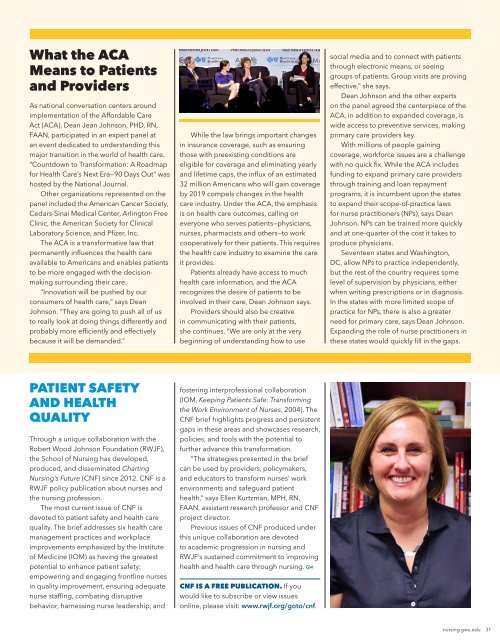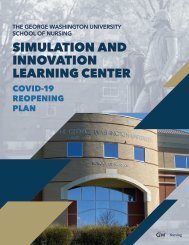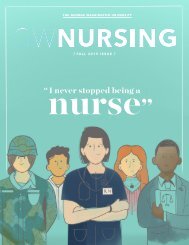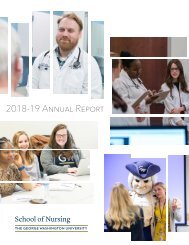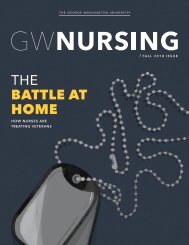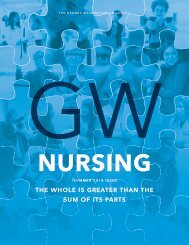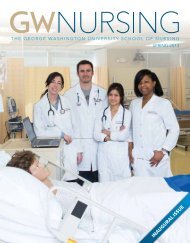GW Nursing Magazine 2014
GW Nursing is a publication of the George Washington University School of Nursing. The magazine tells the story of GW nurses and their endeavors in the areas of education, research, policy and practice.
GW Nursing is a publication of the George Washington University School of Nursing. The magazine tells the story of GW nurses and their endeavors in the areas of education, research, policy and practice.
You also want an ePaper? Increase the reach of your titles
YUMPU automatically turns print PDFs into web optimized ePapers that Google loves.
What the ACA<br />
Means to Patients<br />
and Providers<br />
As national conversation centers around<br />
implementation of the Affordable Care<br />
Act (ACA), Dean Jean Johnson, PHD, RN,<br />
FAAN, participated in an expert panel at<br />
an event dedicated to understanding this<br />
major transition in the world of health care.<br />
“Countdown to Transformation: A Roadmap<br />
for Health Care’s Next Era—90 Days Out” was<br />
hosted by the National Journal.<br />
Other organizations represented on the<br />
panel included the American Cancer Society,<br />
Cedars-Sinai Medical Center, Arlington Free<br />
Clinic, the American Society for Clinical<br />
Laboratory Science, and Pfizer, Inc.<br />
The ACA is a transformative law that<br />
permanently influences the health care<br />
available to Americans and enables patients<br />
to be more engaged with the decisionmaking<br />
surrounding their care.<br />
“Innovation will be pushed by our<br />
consumers of health care,” says Dean<br />
Johnson. “They are going to push all of us<br />
to really look at doing things differently and<br />
probably more efficiently and effectively<br />
because it will be demanded.”<br />
While the law brings important changes<br />
in insurance coverage, such as ensuring<br />
those with preexisting conditions are<br />
eligible for coverage and eliminating yearly<br />
and lifetime caps, the influx of an estimated<br />
32 million Americans who will gain coverage<br />
by 2019 compels changes in the health<br />
care industry. Under the ACA, the emphasis<br />
is on health care outcomes, calling on<br />
everyone who serves patients—physicians,<br />
nurses, pharmacists and others—to work<br />
cooperatively for their patients. This requires<br />
the health care industry to examine the care<br />
it provides.<br />
Patients already have access to much<br />
health care information, and the ACA<br />
recognizes the desire of patients to be<br />
involved in their care, Dean Johnson says.<br />
Providers should also be creative<br />
in communicating with their patients,<br />
she continues. “We are only at the very<br />
beginning of understanding how to use<br />
social media and to connect with patients<br />
through electronic means, or seeing<br />
groups of patients. Group visits are proving<br />
effective,” she says.<br />
Dean Johnson and the other experts<br />
on the panel agreed the centerpiece of the<br />
ACA, in addition to expanded coverage, is<br />
wide access to preventive services, making<br />
primary care providers key.<br />
With millions of people gaining<br />
coverage, workforce issues are a challenge<br />
with no quick fix. While the ACA includes<br />
funding to expand primary care providers<br />
through training and loan repayment<br />
programs, it is incumbent upon the states<br />
to expand their scope-of-practice laws<br />
for nurse practitioners (NPs), says Dean<br />
Johnson. NPs can be trained more quickly<br />
and at one-quarter of the cost it takes to<br />
produce physicians.<br />
Seventeen states and Washington,<br />
DC, allow NPs to practice independently,<br />
but the rest of the country requires some<br />
level of supervision by physicians, either<br />
when writing prescriptions or in diagnosis.<br />
In the states with more limited scope of<br />
practice for NPs, there is also a greater<br />
need for primary care, says Dean Johnson.<br />
Expanding the role of nurse practitioners in<br />
these states would quickly fill in the gaps.<br />
PATIENT SAFETY<br />
AND HEALTH<br />
QUALITY<br />
Through a unique collaboration with the<br />
Robert Wood Johnson Foundation (RWJF),<br />
the School of <strong>Nursing</strong> has developed,<br />
produced, and disseminated Charting<br />
<strong>Nursing</strong>’s Future (CNF) since 2012. CNF is a<br />
RWJF policy publication about nurses and<br />
the nursing profession.<br />
The most current issue of CNF is<br />
devoted to patient safety and health care<br />
quality. The brief addresses six health care<br />
management practices and workplace<br />
improvements emphasized by the Institute<br />
of Medicine (IOM) as having the greatest<br />
potential to enhance patient safety:<br />
empowering and engaging frontline nurses<br />
in quality improvement, ensuring adequate<br />
nurse staffing, combating disruptive<br />
behavior, harnessing nurse leadership, and<br />
fostering interprofessional collaboration<br />
(IOM, Keeping Patients Safe: Transforming<br />
the Work Environment of Nurses, 2004). The<br />
CNF brief highlights progress and persistent<br />
gaps in these areas and showcases research,<br />
policies, and tools with the potential to<br />
further advance this transformation.<br />
“The strategies presented in the brief<br />
can be used by providers, policymakers,<br />
and educators to transform nurses’ work<br />
environments and safeguard patient<br />
health,” says Ellen Kurtzman, MPH, RN,<br />
FAAN, assistant research professor and CNF<br />
project director.<br />
Previous issues of CNF produced under<br />
this unique collaboration are devoted<br />
to academic progression in nursing and<br />
RWJF’s sustained commitment to improving<br />
health and health care through nursing.<br />
CNF IS A FREE PUBLICATION. If you<br />
would like to subscribe or view issues<br />
online, please visit: www.rwjf.org/goto/cnf.<br />
nursing.gwu.edu 31


